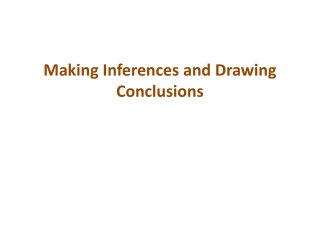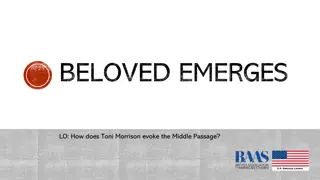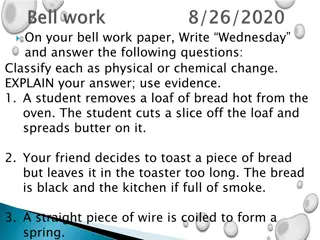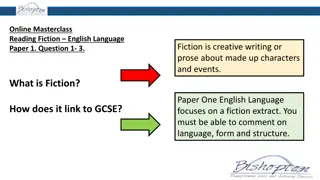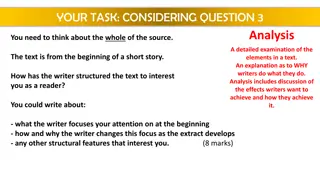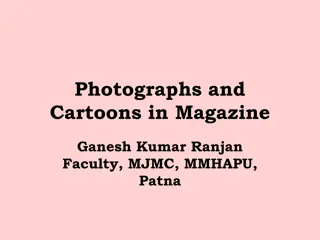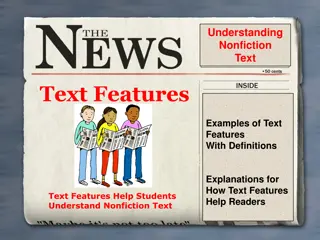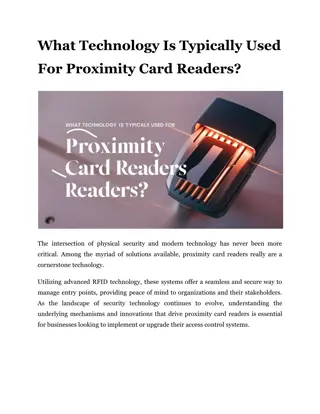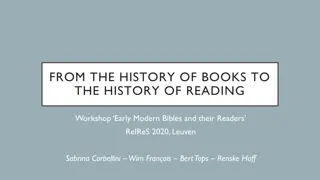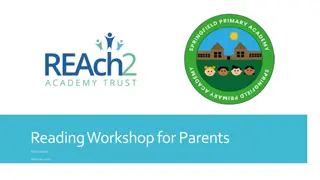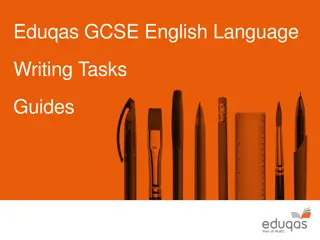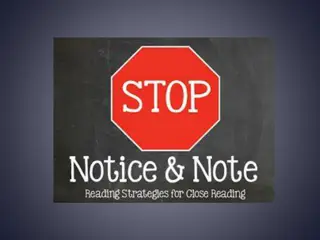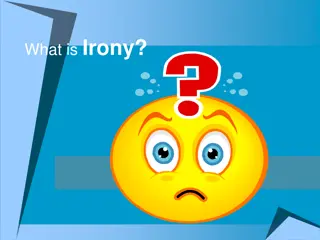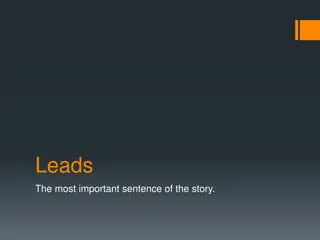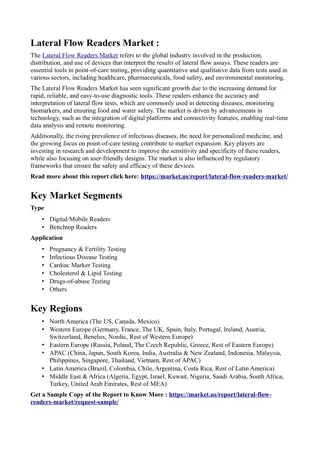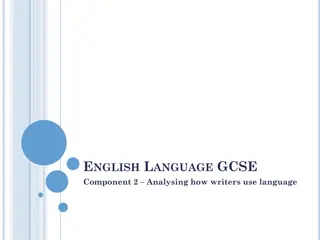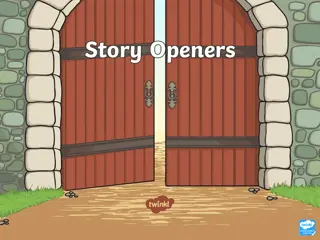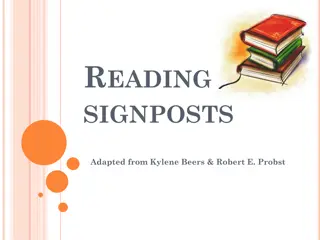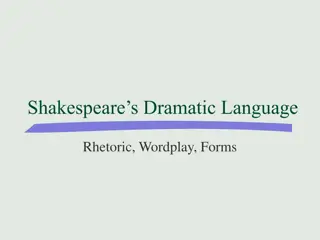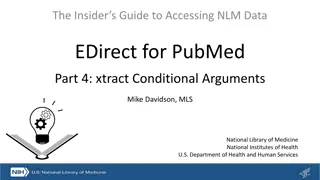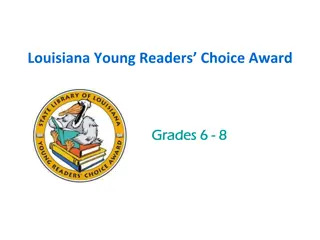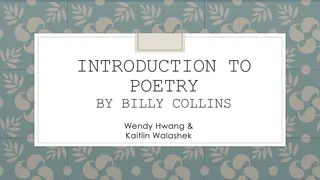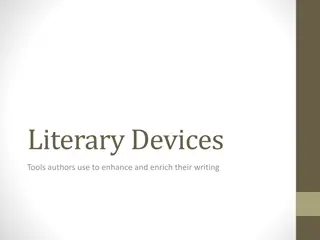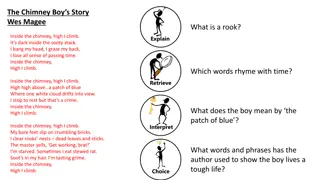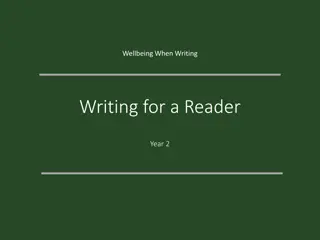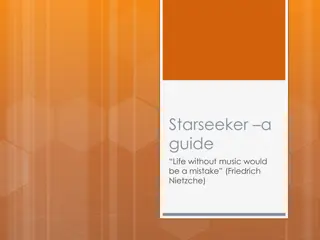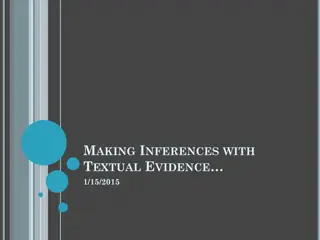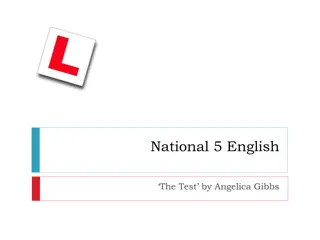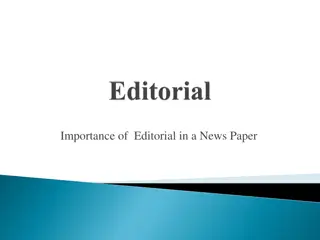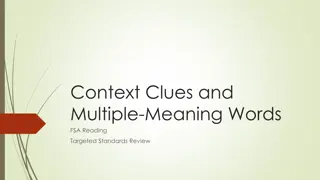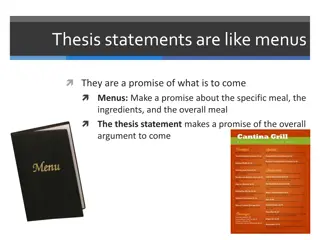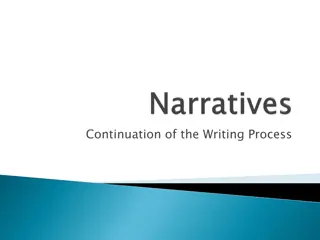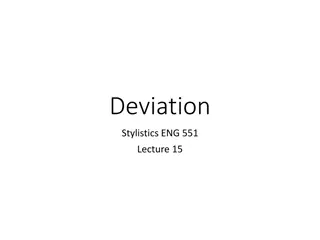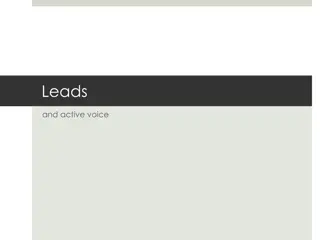Making Inferences and Drawing Conclusions
Readers construct meaning by inferring unstated meanings based on social conventions, shared experience, and shared values. Inferences are evidence-based guesses drawn from what is actually said, enabling readers to understand implications and draw conclusions. Tips for reading include relying on th
0 views • 10 slides
Foreshadowing
Foreshadowing is a literary technique where authors use hints or clues to suggest future events in a story. It builds suspense, engages readers, and makes the narrative more believable. Analyzing foreshadowing involves looking for clues in dialogue and descriptions to predict what might happen next.
0 views • 8 slides
Examining Water Imagery in Toni Morrison's "Beloved" and Its Contextualization with Historical Events
Toni Morrison skillfully evokes the harrowing Middle Passage experience in "Beloved" through water imagery, symbolizing themes of cleansing, rebirth, and trauma. By comparing the water symbolism at various points in the novel, readers can explore its significance in relation to historical events lik
6 views • 14 slides
Classifying Changes as Physical or Chemical
The content provides examples of scenarios involving bread, toasting, and coiling a wire, prompting readers to classify each change as a physical or chemical change. The explanations for each example are supported with evidence, helping readers understand the distinction between the two types of cha
0 views • 13 slides
Understanding Fiction Through Text Analysis: Paper 1 English Language Masterclass
Delve into the world of fiction through an analysis of the novel "Girl With a Pearl Earring". Explore how language, form, and structure are used in the extract to captivate readers. Discover the characters, setting, and narrative techniques employed by the writer to engage and intrigue readers. Unco
1 views • 7 slides
Understanding Text Structure for Analysis
This content provides guidance on analyzing text structure in a literary extract. It explores how writers manipulate elements like setting, time, characters, tone, atmosphere, and dialogue to engage readers. The structured approach helps readers understand and evaluate the impact of these choices on
0 views • 25 slides
The Significance of Photographs and Cartoons in Print Media
In contemporary society, newspapers and magazines heavily rely on photographs and cartoons to inform, educate, and entertain their readers. Photojournalism enhances storytelling by communicating through images, while cartoons offer a humorous approach to discussing serious issues. Both mediums play
0 views • 8 slides
Understanding Text Features in Nonfiction Texts
Text features are essential components of nonfiction texts that authors use to enhance reader comprehension. They include elements such as tables of contents, indexes, glossaries, and titles, each serving a unique purpose in aiding readers to navigate and understand the content. By utilizing these t
1 views • 15 slides
What Technology Is Typically Used For Proximity Card Readers?
Discover the key technologies behind proximity card readers. Learn how they work and what makes them secure and reliable.
1 views • 6 slides
Workshop on Early Modern Bibles and Readers - Insights on Reading Practices
Explore the history of reading through the lens of early modern Bibles and their readers. Discover research methods, strategies, and the cultural significance of books as agents and objects. Delve into the practices and techniques of reading, emphasizing gestures, spaces, and interpretations.
0 views • 15 slides
Effective Strategies for Parental Involvement in Children's Reading Development
Explore how children are taught to read and develop into confident readers in the Reading Workshop for Parents led by Miss Gibson in February 2023. Discover useful strategies to support your child at home, enhance word recognition, comprehension, and fluency, and foster a love for reading. Delve int
0 views • 19 slides
Mastering Guide Writing for GCSE English Language Exam Success
Enhance your guide writing skills for GCSE English Language with this comprehensive presentation covering audience considerations, purpose, register, format, sample questions, and tips for writing successful guides. Dive into the essential elements of guide writing, explore sample tasks, and learn e
2 views • 16 slides
Understanding Literary Signposts for Deeper Reading Comprehension
Authors use signposts as literary tools to guide readers through stories. Just like road signs indicate what's ahead, these signposts in reading highlight important aspects such as characters, conflicts, and life lessons. Notice & Note Signposts like Aha Moment and Again & Again prompt readers to pa
0 views • 23 slides
Exploring the Depths of Irony in Literature
Irony in literature serves as a powerful tool for authors to convey messages in unexpected ways. This content delves into the various types of irony - verbal, situational, and dramatic - providing examples and insights into how each type functions to engage readers and add depth to storytelling. Thr
1 views • 14 slides
Crafting Compelling Leads in Writing: The Art of Snagging Readers
Attracting readers is a skillful craft in writing. The key lies in creating compelling leads that hook readers from the start. Learn the importance of snagging readers, the art of building a lead, and techniques such as humor and curiosity to captivate your audience effectively.
0 views • 21 slides
Lateral Flow Readers Market
The Global Lateral Flow Readers Market size is expected to be worth around USD 3.3 Billion by 2033 from USD 1.7 Billion in 2023, growing at a CAGR of 6.9% during the forecast period from 2024 to 2033.\n\n
0 views • 2 slides
Analyzing Writer's Language Use in English Language GCSE Component 2
In English Language GCSE Component 2, students learn to analyze how writers use language. The learning objective focuses on commenting, explaining, and analyzing language use with relevant subject terminology. The exam assesses students on their ability to interpret and explain a writer's thoughts,
0 views • 12 slides
Mastering Narrative Openers in Writing
Craft compelling story openers to engage readers from the beginning. Learn how to captivate with character descriptions, settings, dialogue, action, intriguing questions, and impactful statements. Explore various techniques to set the tone and draw readers into your narrative world.
0 views • 17 slides
Understanding Reading Signposts for Better Comprehension
Reading signposts, such as Contrasts and Contradictions, Aha Moment, and others, act as signals guiding readers to deeper understanding. They help in staying engaged and comprehend the text effectively by prompting critical thinking and awareness of character behavior and story elements. By recogniz
0 views • 18 slides
Exploring Shakespeare's Dramatic Language and Themes
Shakespeare's dramatic language entails rhetoric, wordplay, and rich forms that offer both pleasure and challenges to readers. His verse showcases density and richness, with characters expressing thoughts through powerful metaphors and figurative language. Examples from "Macbeth" illustrate how imag
0 views • 40 slides
Guide to Accessing NLM Data via EDirect for PubMed
In this comprehensive guide, Mike Davidson, MLS from the National Library of Medicine, delves into accessing NLM data using EDirect for PubMed. The guide covers a range of topics including extracting conditional arguments, limiting output based on conditions, using if-then statements, and ensuring d
0 views • 45 slides
Diverse Selection of Louisiana Young Readers Choice Award Books
A collection of engaging and diverse stories ranging from a humorous account of a summer camp misadventure to an inspiring memoir about overcoming adversity. Explore topics such as identity, friendship, science, resilience, and imagination through these captivating reads. Each book offers a unique p
0 views • 11 slides
Exploring Poetry Through Imagery and Tone in Billy Collins' Work
Diving into Billy Collins' poem "Introduction to Poetry," this analysis delves into the use of imagery, figurative language, tone, and style to convey the poet's frustration with how readers often approach poetry superficially. Collins encourages readers to immerse themselves in the emotional depth
0 views • 5 slides
Exploring Key Literary Devices in Writing
Literary devices such as foreshadowing, suspense, irony, symbolism, and tone are essential tools that authors use to enhance their writing. Foreshadowing hints at future events, suspense keeps readers engaged, irony adds depth, symbolism conveys deeper meanings, and tone sets the author's attitude.
1 views • 16 slides
Poems for Young Readers
A collection of poems for young readers discussing various topics such as a chimney boy's tough life, a supply teacher's challenges, the teeth of sharks, and a humorous incident when Daddy falls into a pond. The poems are engaging and offer insights into different aspects of life.
0 views • 6 slides
Enhancing Reader Engagement Through Effective Writing Strategies
Explore the significance of considering your reader when writing thesis chapters and evaluating the use of incluing to guide readers effectively. Discover techniques used in SF reading protocols to create engaging narratives and build immersive worlds through incluing, challenging readers to piece t
0 views • 11 slides
Starseeker: A Guide to Life Without Music
Starseeker is a captivating novel that explores the profound impact of music on life. Through multiple engaging storylines and deep emotional journeys, readers are drawn into a world where music serves as a powerful force of inspiration and connection. The book resonates with readers of all ages, hi
0 views • 8 slides
Enhancing Reading Comprehension Through Making Inferences
Making inferences is a crucial skill for readers to predict outcomes and understand characters' actions. Textual evidence supports these inferences by providing specific information from the text. In the provided passages about Kyle and Dorothy, readers can infer Kyle's distress from his actions and
0 views • 11 slides
Enhancing Sentence Structure for Engaging Readers
Enhance your writing by adding detail and experimenting with word order in sentences. Learn to move beyond simple structures and engage readers with descriptive and varied sentence constructions. Explore techniques such as expanding sentences with location details, changing the order of words for im
0 views • 7 slides
The Girl in the Lavender Dress: Literal Questions and Inferences
Retold by Maureen Scott, "The Girl in the Lavender Dress" is a mysterious tale that challenges readers with literal questions and inferences about the characters and events. From the unusual girl in a lavender dress to the gripping moments in the car, the story unravels with intriguing textual evide
0 views • 7 slides
Analyzing "The Test" by Angelica Gibbs: Themes of Prejudice and Injustice
The Test" by Angelica Gibbs is a short story that delves into themes of prejudice, injustice, and racism. Through the experiences of the protagonist, Marian, the narrative explores how discrimination affects individuals. The story prompts readers to reflect on issues of bias and unfair treatment in
0 views • 50 slides
The Significance of Editorial in Newspapers
The editorial page in a newspaper serves as a platform for expressing opinions that reflect the publication's stance on various issues. It plays a crucial role in providing analysis, interpretation, and guidance to readers, encouraging them to consider perspectives that prioritize the public good ov
0 views • 32 slides
Understanding Screen Readers and Their Importance in Web Accessibility
Screen readers are crucial software tools that convert digital content into speech or Braille for individuals with visual or cognitive impairments. This article explores the usage of screen readers, recommended software, mobile options, customization settings, navigation shortcuts, skip links, and m
0 views • 11 slides
Understanding Context Clues for Effective Reading Comprehension
Context clues are hints within a text that assist readers in understanding the meaning of unfamiliar words. They can be found in definitions, surrounding sentences, synonyms, antonyms, and cause-and-effect relationships. By recognizing and utilizing context clues, readers can enhance their comprehen
0 views • 15 slides
Crafting Compelling Introductions: A Writer's Guide
Crafting a captivating introduction is like preparing a delicious meal that entices readers to stay engaged. Just like menus and free samples lure diners, introductions hook readers with a promise of what's to come. This guide explores the analogy between introductions and food samples, providing ti
0 views • 16 slides
Mastering Concurrency in Operating Systems: Tips and Strategies
Explore intricate concepts in operating systems concurrency from Chapter 6 of CS 345. Learn practical tips and techniques such as determining the size of arrays, managing readers and writers using semaphores, and tackling the Barbershop Problem. Dive into array manipulation, semaphore usage, and pri
0 views • 37 slides
Enhancing Narratives: Techniques to Engage Readers
Develop captivating narratives by leveraging effective techniques such as engaging narrator characters, utilizing physical characteristics, and focusing on character actions. Dive into the world of storytelling with techniques that bring depth and individuality to your characters, capturing readers'
0 views • 45 slides
Analysis of Robert Frost's Poem "The Road Not Taken
This analysis delves into Robert Frost's renowned poem "The Road Not Taken," exploring themes of decision-making, individual choice, and the consequences of the paths we choose in life. Frost's vivid imagery and nuanced language invite readers to reflect on the complexities of decision-making and th
0 views • 17 slides
The Significance of Deviation in Literature
Linguistic deviation in literature serves to disrupt the normal processes of communication, challenging readers with non-traditional expressions and interpretations. Writers use deviation to create unique aesthetic value in their works, prompting readers to delve deeper into unfamiliar compositions
0 views • 12 slides
Mastering the Art of Writing Engaging Leads and Captivating Readers
Crafting a captivating lead is essential in journalism to entice readers into exploring a story further. This involves using techniques such as compelling photographs, intriguing headlines, and engaging first lines to hook readers from the start. By understanding the importance of strong beginnings
0 views • 36 slides
